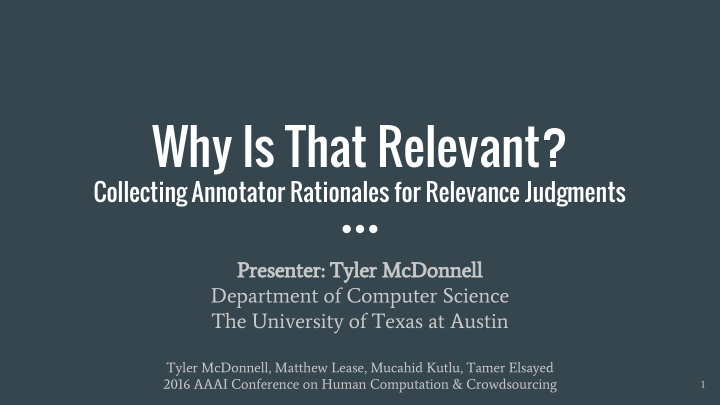



Why Is That Relevant? Collecting Annotator Rationales for Relevance Judgments Presenter: Tyler McDonnell Department of Computer Science The University of Texas at Austin Tyler McDonnell, Matthew Lease, Mucahid Kutlu, Tamer Elsayed 2016 AAAI Conference on Human Computation & Crowdsourcing 1
Search Relevance jaundice What are the symptoms of jaundice? 2
Search Relevance jaundice What are the symptoms of jaundice? 3
Search Relevance 25 Years of the National Institute of jaundice Standards & Technology Text REtrieval Conference (NIST TREC) What are the symptoms of jaundice? ● Expert assessors provide relevance labels for web pages. ● Task is highly subjective: even expert assessors disagree often.* Google: Quality Rater Guidelines (150 pages of instructions!) * Voorhees 2000 4
A First Experiment Collected sample of relevance judgments on Mechanical Turk. ● ● Labeled some data myself. Checked agreement. ● Between workers. ● Between workers vs. myself. ● ● Between workers vs. NIST gold. Between myself vs. NIST gold. ● Why do I disagree with NIST? Who knows! ● 5
Search Relevance Can we do better? 6
The Rationale jaundice What are the symptoms of jaundice? 7
The Rationale jaundice What are the symptoms of jaundice? 8
Why Rationales? 1. Transparency jaundice ● Focused context for interpreting What are the symptoms of jaundice? objective or subjective answers. ● Workers can justify decisions and establish alternative truths. ● Useful for immediate verification and future users of collected data. 9
Why Rationales? 2. Reliability & Verifiability jaundice ● Logical insight into reasoning What are the symptoms of jaundice? reduces temptation to cheat. ● Makes explicit the implicit reasoning underlying labeling tasks. ● Enables sequential task design. 10
Why Rationales? 3. Increased Inclusivity jaundice Hypothesis: With improved transparency What are the symptoms of jaundice? and accountability, we can remove all traditional barriers to participation so anyone interested is allowed to work. ● Scalability ● Diversity ● Equal Opportunity 11
Experimental Setup Collected relevance judgments through Mechanical Turk. ● ● Evaluated two main task types. Standard Task (Baseline): Assessors provide a relevance judgment for a given query, web page. ○ Rationale Task: Assessors provide a relevance judgment and rationale from the document. ○ (will mention two other variants later) ○ ● No worker qualifications. No “honey-pot” or verification questions. ● Equal pay across all evaluated tasks. ● 10,000 judgments collected. (Available online*) ● 12
Results - Accuracy Workers who provide rationales ● produce higher quality work. Rationale tasks provided higher ● binary accuracy (92-96%) than comparable studies (80-82%).* Collecting one rationale provides ● only marginally lower accuracy than five standard judgments. * Hosseini et al. 2012 13
Results - Cost-Efficiency Rationale tasks initially take ● longer to complete, but the difference becomes negligible with task familiarity. ● Rationales make explicit the implicit reasoning process underlying labeling. 14
But wait, there’s more! What about the rationale? 15
Using Rationales: Overlap Assessor 1 Rationale Assessor 2 Rationale 16
Using Rationales: Overlap Assessor 1 Rationale Assessor 2 Rationale Overlap Idea: Filter judgments based on pairwise rationale overlap among assessors. Motivation: Workers who converge on similar rationales are likely to agree on labels as well. 17
Results - Accuracy (Overlap) Filtering collected judgments ● by rationale overlap prior to aggregation increases quality. 18
Using Rationales: Two-Stage Task Design Assessor 1: Relevant Assessor 2: ? Assessor 1 Rationale Idea: Reviewer must confirm or refute judgment of initial reviewer. Motivation: Worker must consider their response in the context of peer’s reasoning. 19
Results - Accuracy (Two-Stage) Single review offers same ● accuracy as five aggregated standard judgments. Aggregating reviewers ● 1 Assessor + reaches same accuracy as 4 Reviewers 1 Assessor + filtered approaches. 1 Reviewer 20
The Big Picture Transparency ● Context for understanding and validating subjective answers. ○ Convergence on justification-based crowdsourcing. (e.g., Microtalk HCOMP 2016) ○ ● Improved Accuracy Rationales make the implicit reasoning for labeling explicit and hold workers accountable. ○ ● Improved Cost-Efficiency No additional cost for collection once workers are familiar with task. ○ ● Improved Aggregation Rationales are a signal that can be used for filtering or aggregating judgments. ○ 21
Future Work Dual Supervision: How can we further leverage rationales for aggregation? Supervised learning over labels/rationales. ● Zaidan, Eisner, Piatko 2007. NAACL 2007 Task Design: What about other sequential task designs? (e.g., multi-stage) Generalizability: How far can we generalize rationales to other tasks? (e.g., images) ● Donahue, Grauman. Annotator Rationales for Visual Recognition . ICCV 2011. 22
Acknowledgements We would like to thank our many talented crowd contributors. This work was made possible by the Qatar National Research Fund, a member of Qatar Foundation. 23
Questions ? 24
25
26
27
Recommend
More recommend